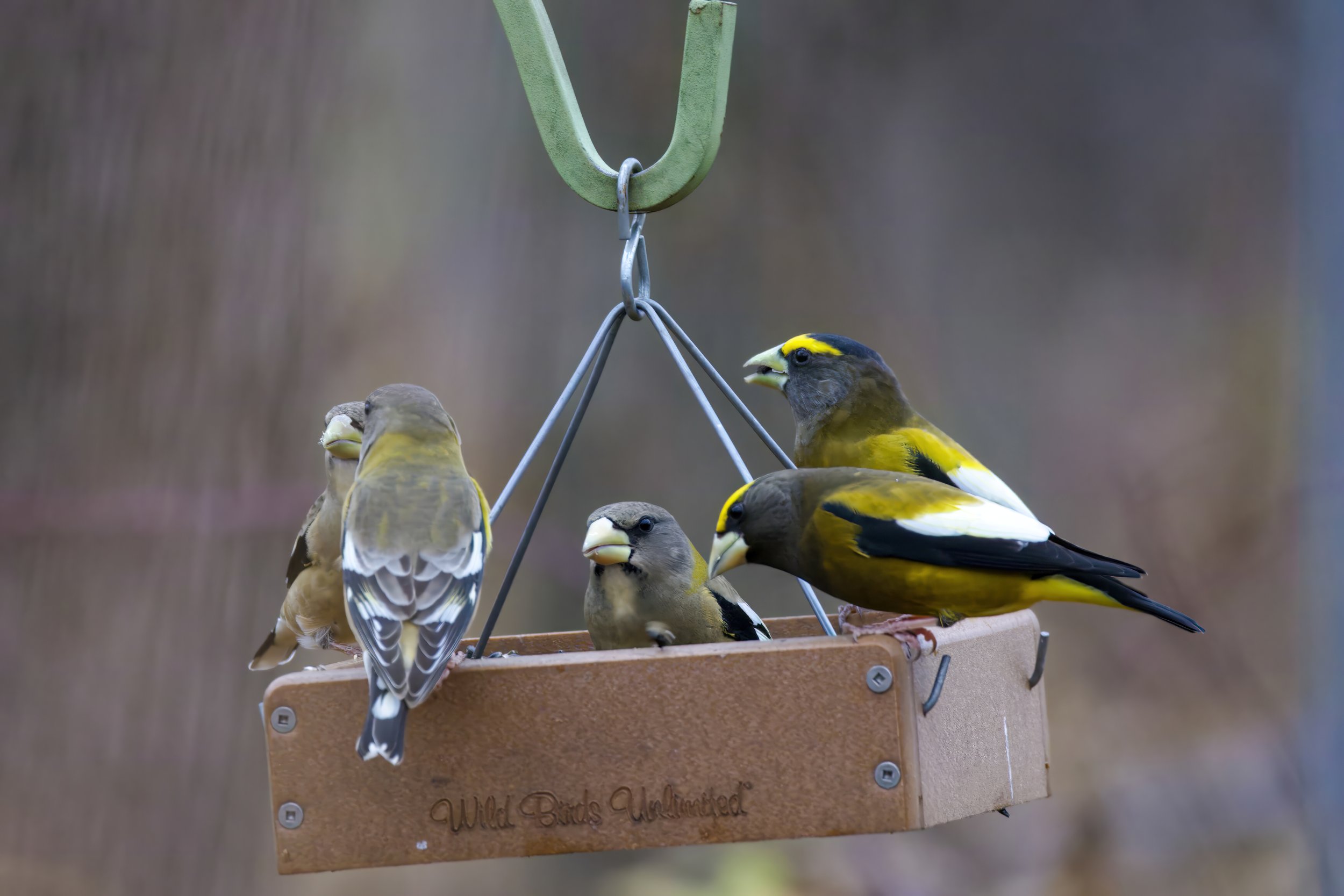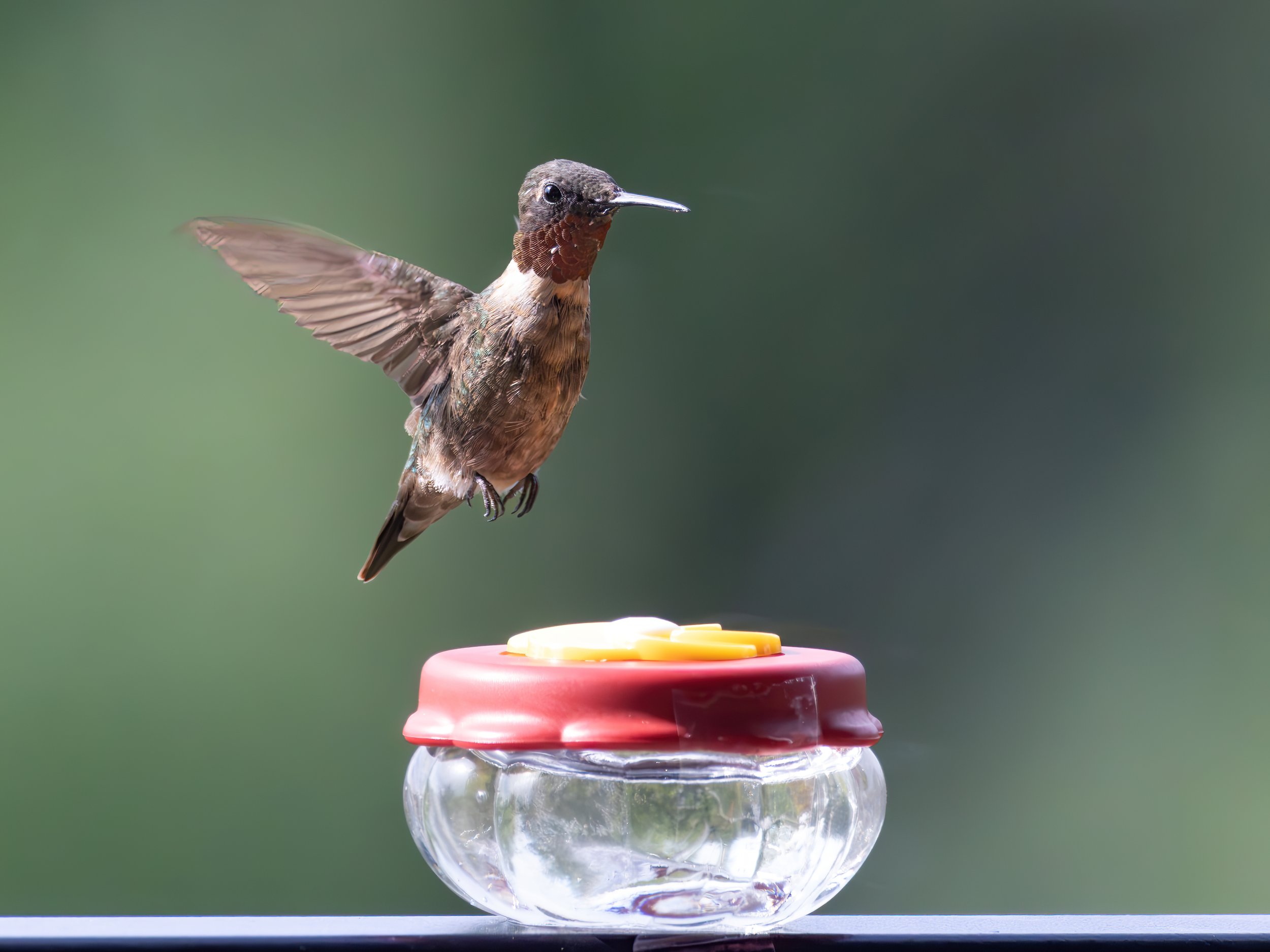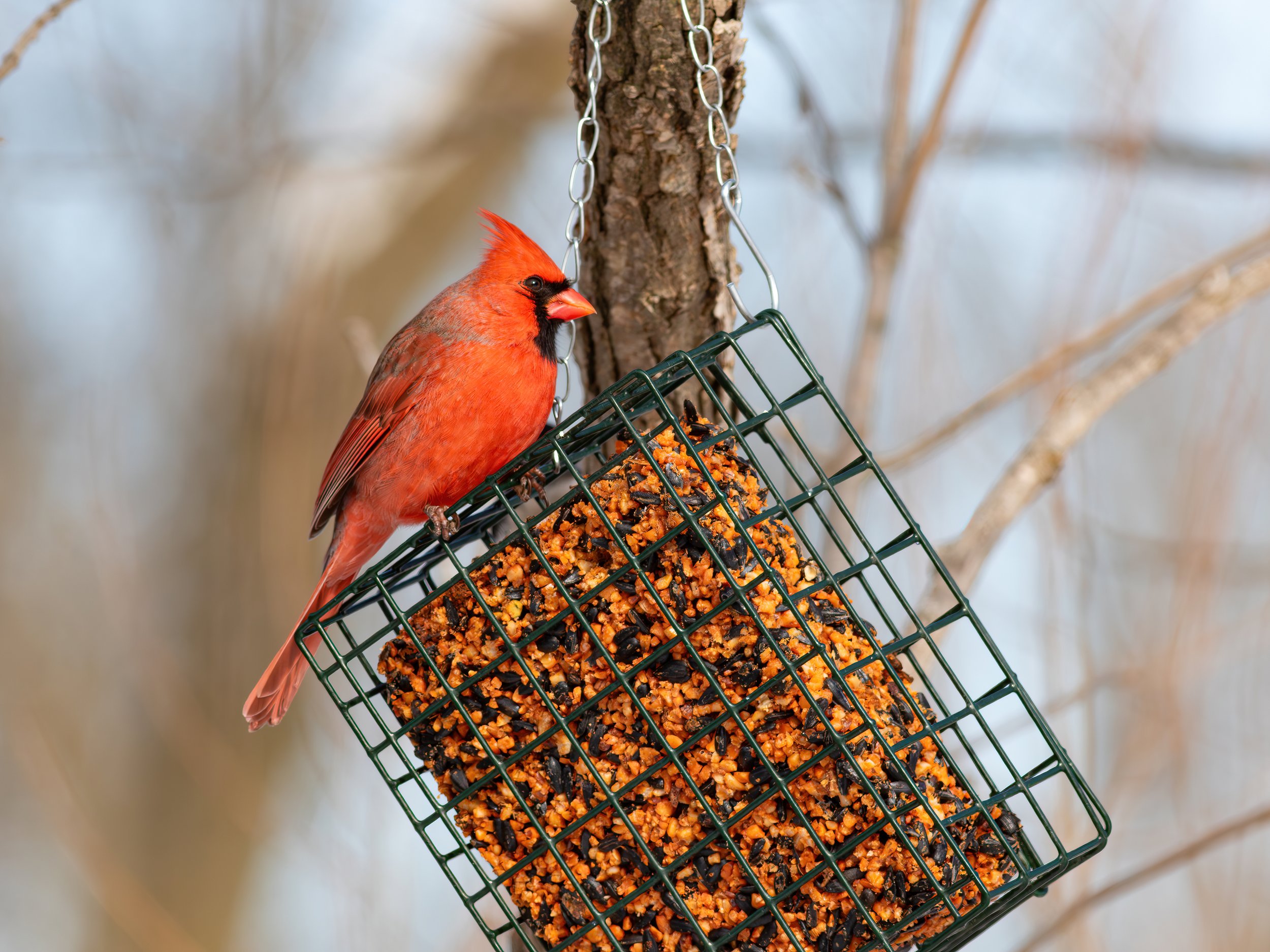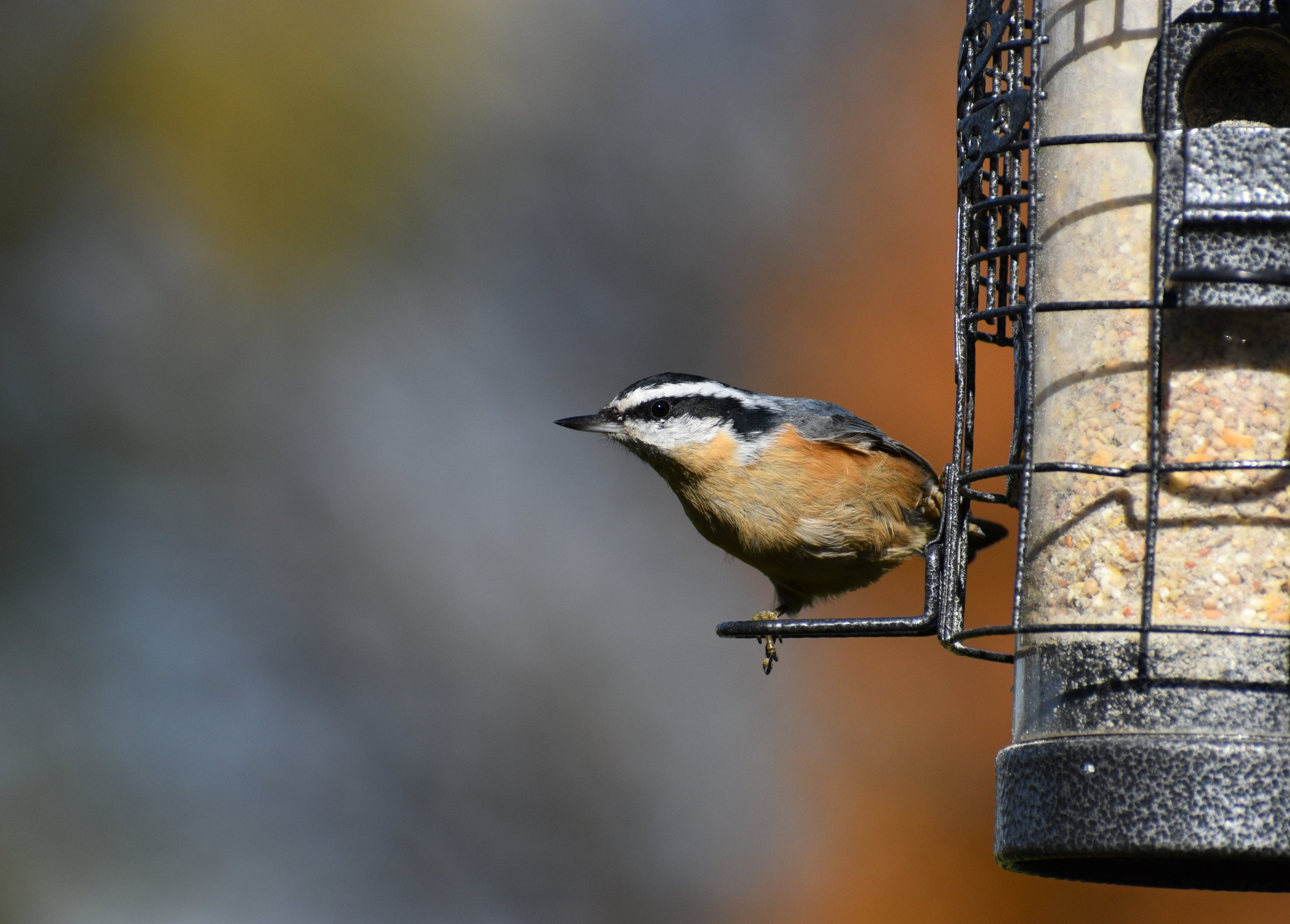Continual Feast
Evening Grosbeak. Campo Sagawau, November 5, 2022. Photo by Ian Sarmiento.
by Kris Hansen
The full version of this article was originally published in the Fall 2023 issue of COS’s official membership publication, The Chicago Birder. To receive this quarterly digital magazine, become a COS member today!
When I was little, my grandmother would take me and my brother and some stale white bread to the river to feed the ducks. We, like the ducks, were delighted. I gained a lifelong soft spot for Mallards. The greedy Mallards probably didn’t do so well.
Processed grain products such as bread, crackers, and cereals have little nutritional value for birds—they are the avian equivalent of junk food. While the occasional crust won’t cause lasting harm, a steady diet of bread like our local ducks received leads to malnutrition, stunted growth in ducklings, spread of disease, and even obesity.
Never fear, grandparents. Defrosted frozen corn or peas, halved grapes, oats, and bird seed are a healthy alternative for feeding your local Anitidae and encouraging a love of birds among your descendants.
All this goes to say that feeding wild birds responsibly is more complicated than you realized.
Sacrifice, Luck, and Enjoyment
The oldest records of bird feeding date to more than 3,500 years ago in the Punjab region of India. Hindi texts recommended that followers provide food, often rice cakes, to birds as well as other wandering beings as one of five daily sacrifices to offset negative karma. Many Hindus follow this practice today.
In Western Europe, particularly Scandinavia, farmers would set aside the last sheaves of grain from the harvest and put it on their doorstep or over the lintel during the winter solstice, hoping that feeding the birds would bring good luck in the new year.
In the United States, Henry David Thoreau extolled the joy of throwing cracked corn to wild birds in, published in 1854. That was just one of many instances of wild bird feeding first documented more than 150 years ago, says Brian Cunningham, director of outreach and nature education for Wild Birds Unlimited (WBU). “In the 1800s, people would simply put food scraps on a stump or porch rail because they liked watching the birds come in,” he says. People also made bird pudding: “They would go to the butcher shop and get suet—beef fat—take it home, render it, add a few things to it, and put it out for the birds to eat.”
Downy Woodpecker and American Tree Sparrow. Private residence, January 23, 2022. Photo by Ian Sarmiento.
By the 1900s, people were putting out seeds instead of food scraps. According to Feeding Wild Birds in America, “bird feeding continued and even grew” throughout the Depression. In the middle of the century, retailers began selling packages of single-type bird seed, such as sunflower seeds. By the late 1900s, bird seed blends became popular. “Now you have a whole array of bird food blends, thistle, suets, and seeds to feed birds at different seasons,” Cunningham says.
The U.S. Fish and Wildlife Service estimated that 59 million Americans aged 16 or older fed wildlife in 2016, at a cost of $4 billion in purchased seeds. Then came COVID. Bird feeding, which already had been on the upswing, boomed while people were stuck indoors. The Wild Bird Feeding Institute, an industry trade group, conducted research in 2021 that indicated 11 percent of people who feed birds began the hobby during the pandemic, underscoring numerous research studies that nature is good for people’s mental health.
One Seed Is Not Like Another
While it is easy to pick up packaged bird seed in your local pet or grocery store, most of those seeds are “seconds,” judged unfit for sale to humans. Packages often contain seeds that are attractive to the human eye but not particularly nutritious or appealing to birds. Blends are created using the cheapest seeds available, keeping prices low and purchasers happy—but not the birds.
David Horn, PhD, professor of biology at Milliken University in Decatur, IL, is a foremost authority on which seeds make birds both happy and healthy. Based on his research, three types of seeds preferred by the widest variety of North American birds. Which one should you use? “The fun thing about feeding wild birds in your yard is that the experience is different for everybody. You get to experiment and see what works best for your yard,” he says.
Horn says that there are two seeds to avoid if you use mixes: cracked corn and red milo, also known as sorghum. “These are not preferred by birds,” he says. “They throw them on the ground, which can attract pests to your feeders.”
Ruby-throated Hummingbird. Private residence, August 15, 2023. Photo by Ian Sarmiento.
Freshness matters, says Cunningham of WBU. Birds simply won’t eat seed that is dried out or moldy. That is the risk of buying bird food from multipurpose retailers—you have no way of knowing how long that seed sat on a pallet in a warehouse.
“You can always test your seed. Get a handful of seeds, put them on apiece of paper towel, and squish them. You should have oil stains,” Cunningham says. Seeds with oils break down faster. If you don’t see oils, throw that seed away. The exceptions are high carbohydrate seeds such as millet, which don’t have oils and last longer. Ground-feeding birds such as sparrows, towhees, and quail love high-carbohydrate seeds.
Cunningham says birds are always looking for the right mix of proteins, carbohydrates, and fats. The proportions they need vary with the season.
Horn notes that there is a growing niche market for organically grown seed or seed that farmers grow as a transitional crop to future organic farming. These seeds are grown without synthetic fertilizers or neonicotinoids pesticides, which are particularly toxic to insects and the birds that feed on them. “Organic bird seed gives folks that are concerned about the quality of the food they are providing an alternative and allows them to support companies that produce organic sunflowers,” Horn says. Illinois is home to a major producer, Prairie Melody in Cerro Gordo, and an increasing number of farmers are transitioning to organic growing.
Whichever feed you choose, store it in a cool, dry place to avoid mold. Airtight containers will help your bird food last longer. If the season is changing and you have extra food, you can freeze it until you are ready to use it.
Northern Cardinal. Private residence, February 2, 2022. Photo by Ian Sarmiento.
How You Feed Is How You Get
“Anyone can just put out some bird food and attract the birds, but if you want to go deeper and understand more about the birds, and you want a greater variety of birds, then you need to have a variety of foods and feeders,” says Cunningham. The combination of feeder types and seeds determines the birds you attract—and the ones you thwart.
If you want to make your yard a bird haven, plant more native plants. Native plants host insects that in turn feed the birds. Some plants have seeds and berries that birds adore. “You don’t have to make it complicated. Add one plant per year. The more native plants you have in your yard, the greater the bird activity you will have, and have it naturally,” Cunningham says.
Make Feeders Safer for Birds
Whichever feeder you choose, it is important to clean it regularly with a 10% bleach solution to kill viruses and bacteria. The Cornell Laboratory of Ornithology recommends cleaning your feeder at least once every two weeks. During migration and other periods of intense bird activity, clean your feeder more often. Feeders made of plastic or metal are easier to clean than those made of wood.
Only put out enough food for one or two days. This prevents food from getting moldy or stale and supports your regular cleaning schedule. Wash your hands before and after handling bird seed.
Rake up discarded seeds and shells from underneath your feeders, which reduces the risk of spreading disease as well as unwanted visits from rodents and other pests.
Be thoughtful about where you put your feeders, Horn says. Place your feeders within three feet of your windows, a distance that diminishes bird strikes. They will get used to your presence.
In addition, position feeders 10 to15 feet from trees and evergreens. This distance enables birds to get into cover if a Cooper’s Hawk comes by while being too far for most squirrels to jump. Keep low-hanging or ground feeders 15 feet or more from shrubs to give birds time to spot four-footed predators, including domestic cats.
Lastly, spread out your feeders so birds aren’t all in the same location, which diminishes disease transmission.
Before your head explodes with all these recommendations, Horn says remember that your feeders are also for you: “Put the feeder where you can enjoy looking at the birds.”
To Feed or Not to Feed?
Numerous scientific studies show that wild birds use feeders as a beneficial supplemental food source rather than a primary source of nutrition. “Feeding the birds is not altering what they do in nature. They still feed regularly on the foods they normally feed on. You are not making them dependent on the food you are offering. They are using it as a supplement,” says Cunningham of WBU, who regularly reviews scientific studies looking for pros and cons of bird feeding.
In a study led by Horn, birds who consistently had access to good birdseed were healthier than birds who received no supplemental food. As soon as the supplemental food was removed, the birds returned to their previous health.
Another study in Wisconsin showed that, during periods of weather below 10 degrees Fahrenheit, Black-capped Chickadees without access to supplemental feeding suffered a major die-off, while populations that received supplemental feeding had a significant survival rate.
Cunningham says, “Studies have shown that with supplemental feeding, birds will nest a little earlier, they will generally lay one more egg, and they will fledge their babies earlier by 1 to 3 days than others that don’t have supplemental feeding. The bird seed essentially ensures they have the right nutrition to do what they need to do sooner and more successfully.”
Purple Finch. Little Red Schoolhouse, February 12, 2022. Photo by Ian Sarmiento.
Bird feeders do make birds more susceptible to disease, predation, and collision, Cunningham acknowledges. “Birds congregate around birdfeeders, whereas in nature, they are bouncing around. They may all be feeding in the same tree, but they are not all showing up to the same branch.” Just as with people, when birds are in proximity, they can spread diseases such as salmonellosis and conjunctivitis, previously known as finch eye disease.
Feeders also can enable diseased birds to survive migration when they otherwise would have died, says Daniel Becker, PhD, who conducts research on wildlife immune function and infectious diseases as an assistant professor of biology at the University of Oklahoma.
“Migratory culling is bad for individuals, but it is good for the population,” he says. “One theory is that migration itself evolved to get parasites out of the system.”
In birds that overwinter, diseases such as avian malaria recede to a low level, then flare up again in the spring. Becker is studying Dark-eyed Juncos and Harris’s Sparrows to see how feeders impact the disease: “Do infections flare more or less at feeder sites? Does feeding buffer migration-induced relapses or make them worse?”
Becker notes that people who feed birds, unlike tourists who feed wildlife or leave trash behind, work to protect the health of the birds.
“Bird feeding is so distinctive because it is community of caring,” Becker says. “People care about the quality of the food, about keeping feeders clean. They make the practice as positive as they can.”
If you notice signs of disease around your feeders, it’s important to take them down, clean them thoroughly with a bleach solution, and put them away for a couple of weeks to allow the birds to disperse.
A Bird in the Hand
If you’ve visited Montrose Point Bird Sanctuary, you’re familiar with the Black-capped Chickadees and Northern Cardinals that follow you, begging for food. Hand-feeding birds, or spilling seed on the walking paths or ground, is strictly prohibited in all Chicago parks and Cook County forest preserves, including Montrose Point. COS recommends that all its members follow these rules to protect the birds we work so hard to conserve.
Common Redpoll. River Trail Nature Center, February 24, 2022. Photo by Ian Sarmiento.
Montrose Point, like most birding hotspots in the park district and forest preserves, has plenty of native plants that provide ample food for their avian residents and migrants; commercial seed of low quality spread in bulk may have undesirable consequences. Former COS president Jill Niland is concerned about the quantity of seed she has seen scattered at Montrose. Last winter she observed a man dump several pounds of seed on the asphalt. “That kind of feeding can encourage unwanted species, too,” she says. “Mostly House Sparrows seemed to be eating it.”
Large dumps of seed also encourage birds to congregate in dense numbers, easing the spread of disease. While some area nature preserves have bird feeders, these are carefully cleaned and monitored by park district staff; the same cannot be said for DIY bird feeding areas without any oversight.
Even more concerning to some is the practice of hand-feeding birds at Montrose Point. “It's disconcerting to have a choir of trained chickadees, cardinals, and sparrows follow one around in the winter months, since they associate birders with being fed,” says Niland. Frequent Montrose birder Matthew Cvetas points out that bird feeding has become “very visible” at this hotspot. “Hand-feeding birds can be a thrilling experience short term,” notes Cvetas, “but it is a selfish endeavor long term, as it can alter the birds’ behavior in harmful ways.”
Stephanie Beilke, COS board member and Senior Manager of Conservation Science at Audubon Great Lakes, echoes Cvetas’ reasoning. “I’m not a huge fan of hand-feeding because it leads to habituation, so birds tend to lose their natural fear of people.”
This lack of fear can make birds a nuisance and aggressive, putting them in harm’s way of humans who would prefer to not be bothered. It also puts humans in harm’s way of them. “Hand-feeding Red-winged Blackbirds gives them the training needed to maneuver around the brim of even the widest of ballcaps,” writes Matthew Dolkart, another frequent Montrose birder. “For the sake of style, and the hair on my skull, please don’t hand-feed the Red-winged Blackbirds.”
On a more serious note, habituating birds to humans can make them vulnerable to illegal trapping. Primarily an issue in Florida, where buntings, cardinals, and grosbeaks are trapped for singing competitions, trapping wild birds has also popped up in other parts of the country. Robyn Detterline, editor of this publication, is aware of at least one recent instance in the Chicagoland area when unwitting bird lovers were gifted a caged Red-winged Blackbird. (Of course, it is impossible to know whether the bird was trapped as a result of him being trained to feed out-of-hand.)
Still, hand-feeding birds will always have its charms for those who partake. “If I see it happening, I try not to judge,” says Beilke. “Everyone connects to nature in their own unique ways, and hand-feeding could sometimes be the gateway to the bigger birding and conservation world for some folks.”
This seems to be the story in Kensington Metro Park in Milford, MI, which has allowed visitors to feed birds by hand for more than 75 years. Noted wildlife photographer Joceyln Anderson chronicles the wide variety of birds that flock to her at every visit.
“It’s wonderful to have the trust of a wild creature, to feel the light touch of their little feet,” Anderson says. “I’ve been feeding birds in this park for seven years, almost every day, and it is absolutely magical. It never gets old.”
Red-breasted Nuthatch. Tinley Park, November 6, 2020. Photo by Maxima Gomez-Palmer.
Cunningham concurs: “It’s magical when you have a bird land in your hand and you realize that they weigh nothing. There’s just a connection there. It’s feather therapy.”
Anderson only feeds birds by hand at Metro Park and follows the rules established by fellow wildlife photographer Melissa Groo:
Is this species at risk?
Is the food appropriate and safely provided?
Is feeding this bird likely to change its behavior in harmful ways?
Plus one more, specific to Metro Park: Only feed birds that can land in your hand.
“Metro Park is amazing. It has a Great Blue Heron rookery, and there are Great Egrets and Sandhill Cranes,” she says. Despite not being able to fit into anyone’s hand, the cranes are sometimes fed, and they can be aggressive, says Anderson.
“I’ve been chased, one of them has struck my foot, and they’ve gone after my camera,” she says. “It’s one thing if a chickadee is mad at you, and quite another if it’s a Sandhill Crane.”
Even small birds can freak some people out, says Cunningham.“ Alfred Hitchcock didn’t help. There are plenty of people who, if a bird is following them, are going to be scared to death. Not everyone is comfortable with a bird approaching them.”
If you do want to try hand-feeding in your yard, Anderson suggests you start in January or February, when food is getting scarce. Use a feeder to get birds used to finding food in your yard. Then, once a day, hide the feeder and hold food in your hand in the same location. Another tactic is to create a seated mannequin with coat, hat and gloves and put seed in the glove. Then, one day, it’s you in the chair with seed in your hand.
“In both cases, the birds are familiar with your yard. They know that this is where I come to get food,” she says. “Then you wait for the magic to happen.”







